- New Sailboats
- Sailboats 21-30ft
- Sailboats 31-35ft
- Sailboats 36-40ft
- Sailboats Over 40ft
- Sailboats Under 21feet
- used_sailboats
- Apps and Computer Programs
- Communications
- Fishfinders
- Handheld Electronics
- Plotters MFDS Rradar
- Wind, Speed & Depth Instruments
- Anchoring Mooring
- Running Rigging
- Sails Canvas
- Standing Rigging
- Diesel Engines
- Off Grid Energy
- Cleaning Waxing
- DIY Projects
- Repair, Tools & Materials
- Spare Parts
- Tools & Gadgets
- Cabin Comfort
- Ventilation
- Footwear Apparel
- Foul Weather Gear
- Mailport & PS Advisor
- Inside Practical Sailor Blog
- Activate My Web Access
- Reset Password
- Customer Service

- Free Newsletter


Tartan 30: An Affordable Classic

Ericson 34-2 Finds Sweet Spot

How to Sell Your Boat

Cal 2-46: A Venerable Lapworth Design Brought Up to Date

Solar Panels: Go Rigid If You have the Space…

Leaping Into Lithium

The Importance of Sea State in Weather Planning

Do-it-yourself Electrical System Survey and Inspection

When Should We Retire Dyneema Stays and Running Rigging?

Rethinking MOB Prevention

Top-notch Wind Indicators

The Everlasting Multihull Trampoline

What Your Boat and the Baltimore Super Container Ship May Have…

Check Your Shorepower System for Hidden Dangers

DIY survey of boat solar and wind turbine systems

What’s Involved in Setting Up a Lithium Battery System?

Waste Not is the Rule. But How Do We Get There?

The Scraper-only Approach to Bottom Paint Removal

How to Handle the Head

The Day Sailor’s First-Aid Kit

Choosing and Securing Seat Cushions

Cockpit Drains on Race Boats

Re-sealing the Seams on Waterproof Fabrics

Safer Sailing: Add Leg Loops to Your Harness

Waxing and Polishing Your Boat

Reducing Engine Room Noise

Tricks and Tips to Forming Do-it-yourself Rigging Terminals

Marine Toilet Maintenance Tips

Learning to Live with Plastic Boat Bits
- Sailboat Reviews
O’Day 30
With good performance, low maintenance, and a big interior, the 30 is a good coastal cruiser..
The first O’Day 30 we saw back in 1977 was named Moby Dick . Compared to most of the boats in our boatyard, she did look a lot like a great white whale: beamy white hull with high topsides, white deck, white cabin trunk, and not much exterior wood trim. But what really struck us about the boat was the amount of interior volume. The boat had as much interior space as most 34-footers built at that time.
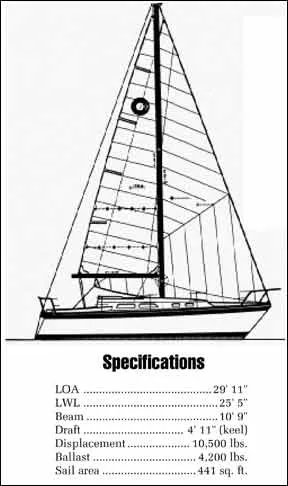
With her straight sheerline and short overhangs, the O’Day 30 was not as handsome to our eyes then as more traditional-looking boats, but the design has held up surprisingly well. Today it still looks quite modern, yet more conservative than many newer Eurostyled boats.
Over 350 O’Day 30s were built between 1977 and 1984. During 1984, the 30 was modified by changing the keel and rudder, and the stern was lengthened to accommodate a European-style boarding platform. This “new boat” was called the O’Day 31, and it stayed in production until 1986.
O’Day 31 hulls are numbered, quite correctly, as a continuation of the O’Day 30 series. About 150 “stretched” O’Day 31 models were built.
Sailing Performance
With a typical PHRF rating of 177, the O’Day 30 is very close in speed to other modern cruiser/racers of the same length. The boat was never marketed as a racing boat: performance cruising has always been an O’Day concept.
The boat was originally built in two underwater configurations: a keel/centerboarder, and a fin keel of moderate depth. The centerboard version of the boat is about 500 pounds heavier than the keel version. The extra weight is mostly in ballast to give the two boats similar stability. Where PHRF committees distinguish between the two underwater configurations, the centerboard boat is rated about three seconds per mile slower—about what you would expect for the difference in displacement.
Upwind performance is good. Shrouds and genoa track are inboard, and the hull and keel shape from C. Raymond Hunt Associates is clean and modern without being extreme. Downwind, the boat is slow without a spinnaker.
The mainsail is very high aspect ratio, almost 4:1. Off the wind, this is ineffective sail area, and a poled-out headsail will not provide enough area in light air to really keep the boat moving. At the very least, an asymmetrical cruising spinnaker is called for.
Because the mainsail is small, the boat needs large headsails, and they will need to be changed frequently for optimum performance. With a small main, reefing is a relatively ineffective way to reduce sail area.
Standard sails with new boats were a main and 110% jib. In addition, the boat really needs a 150% genoa and a 130% genoa for good performance in a wide range of wind velocities. With a wide waterline beam and 40% ballast/displacement ratio, the boat can carry a fair amount of sail.
Unless the original owner specified the optional larger headsail sheet winches, you’ll have to consider upgrading if you go to big genoas: the stock winches are too small for headsails larger than 110%.
Most owners report the boat to be well-balanced under sail, but some early boats suffered from a lot of weather helm due to an excessively-raked mast. The solution is to shorten the headstay and eliminate almost all mast rake. This may require shifting the mast step aft 1/2″ for the mast to clear the forward edge of the mast partners.
Although the rig size did not change over the course of production, spars from three different manufacturers were used in the boat. The original rigs are by Schaefer. Kenyon spars were used in the middle of the production run, Isomat rigs in later boats. All the rigs are stepped through to the keel, and are properly stayed.
The standard location for the mainsheet traveler is on the bridgedeck at the forward end of the cockpit. From a purely functional point of view, this is a good location. Several owners in our survey, however, complain that the traveler limits the installation of a cockpit dodger. As an option, the mainsheet traveler was available mounted on a girder atop the deckhouse.
This is a tough call. The bridgedeck location is very handy for shorthanded cruising, since the person steering can reach the mainsheet from the helm, particularly on tiller-steered boats. At the same time, a good dodger is almost a must for cruising, and the midboom sheeting arrangement simplifies dodger design.
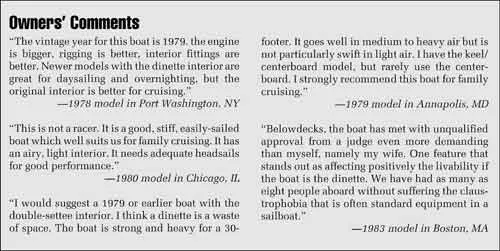
Although wheel steering was an option, you’ll find it on a large percentage of boats. Owners report no problems with the wheel installation. Early boats have a conventional, centerline backstay. On later models, a split backstay was standard, permitting a stern boarding ladder to be mounted on centerline.
All things considered, the O’Day 30 is a boat that performs well under sail. She’s not really a racer, but she will stay up with almost any boat of her size and type, and is easy to handle, to boot.
O’Day was one of the first big builders to take the all diesel route, even though the Atomic 4 was still a popular engine when this boat went into production. Not all of the engine installations in the O’Day 30, however, have been equally successful.
Originally, the boat was equipped with a singlecylinder, salt water cooled, 12 hp Yanmar diesel. This was one of the first Japanese diesels on the market, and one O’Day 30 owner reports that Yanmar replaced his engine—three years after the boat was built—due to a series of problems that simply could not be solved.
During 1978, the engine was upsized to a Yanmar 2QM15, since the boat was really underpowered with the smaller engine. Owners report that Yanmar installations are noisy, which is partially due to the fact that there is no sound insulation in the engine compartment.
As first built, the engine beds were attached to the walls of the engine box. According to one owner, this was such a bad arrangement that the vibration from the engine loosened the beds. Later boats have a molded fiberglass engine bed/drip pan combination, which is far better than the original installation.
With 1980 models, the Yanmar engine was dropped in favor of a two-cylinder, 16 hp Universal diesel. Owners report no problems with this engine.
Engine access is very good, particularly on later models. In early models, a panel behind the companionway ladder must be unscrewed to get to the front of the engine. On later models, a sloping panel in front of the engine can be removed, and the galley counter over the top of the engine can be lifted out of the way for complete access.
Lack of sound insulation is the weak point of the engine installation. It probably would have cost about $100 to provide halfway-decent sound insulation in the engine compartment when the boat was on the assembly line. You can do it after the fact, but not as simply or cheaply. We’d highly recommend this project, since without insulation the engine compartment resonates like a drum.
With the exception of the original, single-cylinder Yanmar, all of the engines are big enough to push the boat to hull speed in most conditions.
The standard, exposed, two-bladed solid prop causes a fair amount of drag under sail, but you should probably keep it unless you race. We feel a folding prop is not the way to go on a cruising boat, and a feathering prop would be disproportionately expensive on this boat.
Early boats have an 18-gallon aluminum fuel tank. Later models—after 1980—are usually equipped with a 26-gallon aluminum tank. The larger tank gives better range under power, despite the fact that the more powerful engines used late in the production run also use more fuel.
Construction
The hull of the O’Day 30 is an uncored fiberglass laminate. Hull stiffness is increased through the use of a full-length molded body pan, glassed to the hull. Construction is basically solid, but is certainly not fancy. Owners in our survey report a fairly standard number of minor production-boat complaints: surface crazing in gelcoat, leaks around mast, leaks around deck hardware and ports, poor interior finish quality. Gelcoat blistering is neither more nor less common than on other boats.
The O’Day 30 was one of the first small cruising boats to use Navtec rod-type chainplates, which are anchored to the body pan. This is a good, strong arrangement.
In our experience, O’Day’s approach to building was to use good-quality fittings, combined with reasonably sturdy construction. The boats generally have pretty mediocre finishing detail, and costs were kept down by keeping the standard boat fairly simple.
For example, there is no sea hood over the main companionway. This may seem like a minor shortcoming, but it means that this hatch is going to leak if you take solid water over the deck. Instead of a labor-intensive full-length teak toerail, there are short, thin teak strips screwed to a raised, molded fiberglass toerail. The strips do not have to be curved or tapered, since they can be easily bent to shape.
Likewise, most of the interior furniture is part of the molded body pan, trimmed out with teak. The cabin sole is fiberglass, with teak ply inserts. You do not buy these boats for their high-quality joinerwork, nor do you buy them for sophisticated systems or creature comforts.
A single battery was standard, as was a two-burner alcohol stove without oven. Propane cooking was not an option. Double lifelines were optional. Even a spare winch handle was an extra-cost option: only one winch handle was supplied, although four winches were standard!
Because the O’Day 30 is a relatively heavy boat, its basic construction is fairly expensive. To keep the price comparable to other boats in its size range, costs had to be cut somewhere, and they were cut in finish, detailing, and systems. You simply can’t build a boat that weighs 500 to 1000 pounds more than the competition, provide the same systems and detailing, and keep the price the same.
All in all, this is a reasonable tradeoff. You could, if you wanted, add a propane stove, bigger batteries, engine compartment insulation, bigger winches, and many of the other things that you might expect to find on a well-equipped 30-footer. But you won’t get your money back when you sell the boat. The price of your used O’Day 30 will be controlled by the price of other O’Day 30’s on the market, even if they are less well equipped than your own.
The standard water tank varies in capacity from 25 to 30 gallons, depending on the model year. On late models, which have the smaller tank, you could also get an extra 25-gallon water tank, which is mounted under the port settee. With this tank full, the boat has a noticeable port list. Without the optional tank, water capacity is inadequate for cruises extending beyond a long weekend.
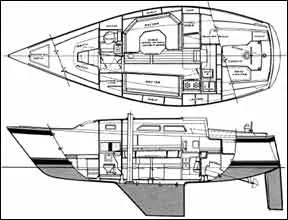
Deck layout is reasonably good. There is an anchor locker forward, although its so large that it’s tough to straddle while hauling in the anchor rode. You can walk forward on deck outboard of the shrouds on either tack.
The cockpit is fairly small, thanks to the big interior. There is a large locker to port that can be used to store sails, and a small locker to starboard at the aft end of the cockpit.
With 1980 models, ballast was reduced by 350 pounds in the keel version, 400 pounds in the centerboard boats, according to factory specifications. Still later, ballast in the keel version was increased by 150 pounds. Although these are significant changes, owners of later boats do not report that the boat is noticeably more tender, nor do the PHRF ratings reflect any change in performance.
With her wide beam and long waterline, the O’Day 30 has a big interior. In fact, we have little doubt that if the boat were still in production, O’Day would have figured out how to modify the interior to get three in separate cabins, which has become fairly common on contemporary 30-footers.
For the first three years of production, the boat had a very standard interior, with settees on either side of the main cabin. In 1980, the interior was retooled. The starboard settee was replaced with a U-shaped dinette with permanent table, and the head compartment was shifted to the starboard side of the boat.
The forward cabin in the old layout is bigger due to the placement of partitions and doors, which gave more cabin sole area. With the V-berth insert in place to give a double berth, you could still stand up in the forward cabin to dress. In the newer interior, there is no place to stand in the forward cabin if the door is shut.
Headroom is 6′ on centerline in the forward cabin. There is a molded fiberglass hatch in the forward end of the cabin trunk. In our experience, molded glass hatches are a compromise. They are easy to distort by overtightening hatch dogs to compensate for old gaskets. If dogged unevenly, they tend to leak. It is also next to impossible to fit a dodger on a hatch like that on the O’Day 30, so it must be kept shut in rain or bad weather. Since the boat lacks any real provision for foul-weather ventilation, it can be stifling below.
Although the head compartment in both interior layouts is small, it’s a fairly good arrangement. To use the optional shower, doors to both the main and forward cabins can be closed off, giving plenty of elbow room. Unfortunately, the shower drains to the bilge, a nasty arrangement.
In the original layout, a dropleaf centerline table divides the middle of the main cabin. Four people can sit comfortably at the table using the two settees.
Four diners are far more cramped in the dinette than with the two-settee arrangement, even though O’Day’s literature claims space for five. There’s no way that anyone seated on the port settee opposite the dinette can reach the table. On the plus side, fore and aft movement through the boat is not restricted by the dinette, as it is in the two-settee interior when the table is in use. You pays your money and takes your choice on this one.
Storage space behind the settees shrank in the new interior, a significant loss on a boat this size.
The dinette table drops down to form a good-sized double berth, but because the mattress is made up of five (count’em) separate cushions, this is not a very comfortable berth to sleep on. Its shape is so complex that making sheets fit well is just about an impossibility. In the old layout, the port settee can be extended to form a more normally-shaped double.
Even with opening ports, ventilation in the main cabin is pretty mediocre. There is room atop the cabin aft of the mast for a small aluminum-framed ventilation hatch, and this was an option on later boats. If you don’t have the hatch, you should add it. Cowl vents—other than one on the foredeck—weren’t even options, but could be added.
Headroom in the main cabin is 6′ 3″ on centerline aft, slightly less at the forward end of the cabin. The galley and nav station are the same in both interiors, but some detailing varies depending on the year. Aft to port there is a stove well, with storage outboard.
The icebox is in the aft port corner of the galley. It is not particularly well insulated, and drains into the bilge. There is a deep single sink next to the icebox.
Originally, there was a long step from the companionway to the top of the galley counter, to which a teak board was fastened to form a step. Stepping on galley counters offends our sensibilities, since we prefer to delete the sand from our sandwiches.
Later boats have a more conventional companionway ladder, eliminating the giant first step and the possibility of a foot in the middle of your lasagna, but making it difficult to use the galley counter, now hidden behind the ladder. There is a compact nav station opposite the galley. It has a small chart table, and some storage and space for electronics outboard. The chart table must be kept small to give access to the quarterberth.
You’ll find the electrical panel in one of two places: under the bridgedeck in the galley, or outboard of the chart table. The nav station location offers more protection from water coming down the companionway—which it will—but space for electronics is sacrificed.
Sales literature refers to the quarterberth, which is 41″ wide at its head, as a “cozy double.” Cozy isn’t really the word for a “double” berth that tapers to less than 2′ wide at the foot. Forget it. Many owners have added an opening port from the quarterberth into the cockpit, and this helps ventilation a lot.
The interior of any 30′ boat is a compromise. For the coastal cruising for which she was designed, the interior of the O’Day 30 is spacious and functional, and is probably the boat’s best selling point.
Conclusions
With her good performance and big interior, the O’Day 30 makes a reasonable coastal cruising boat. This is a low-maintenance boat, with little exterior wood. Along with low maintenance, you get pretty plain-Jane appearance.
The boat still looks modern. If she appeared in a boat show today, she wouldn’t look dated.
Unless you need shoal draft, we’d opt for the deepkeel boat, for its simplicity, if nothing else.
The extended stern of the O’Day 31 makes that boat much better looking in our opinion, since the big, fat stern of the 30 is probably her least attractive feature. The 31′ boat is far more expensive on the used boat market, however, so you have to decide how much you’re willing to pay for improved looks and a boarding platform.
Compared to a lot of newer 30-footers, the O’Day is quite heavy, but we consider that a plus for a boat that may sail in fairly exposed waters. For the type of use most boats this size will get, the boat looks like a good value on the used boat market. You could spend a lot more money for a lot less boat.
RELATED ARTICLES MORE FROM AUTHOR
Good day to you. I am having a hull problem with my 1980 oday30. I bought it only a few years ago and when i was getting her ready for this season sailing i noticed a small hole where the bilge pump sits so i took it off and apparently ice had formed over the winter causing the inside layer to crack. This allowed moisture to enter and soak a good section of the hull above the fiberglass hull. I am getting conflicting reports how to fix this. Some say take all of the first layer out and re core it and fiberglass again. And some say you can fix the core with little attention to really fixing the problem. I have a hole about 1 foot by 5 inches and all cleaned up but i am pretty sure there is still moisture forward of the hole and near the mast. Ok so i am looking for your opinion please and thank you!!!
I just used Injectadeck. Worked great for a similar problem in my cabin.
LEAVE A REPLY Cancel reply
Log in to leave a comment
Latest Videos

Fuel Contamination? The Baltimore Francis Key Bridge Collapse

Safety At Sea For You & Your Family – The Joe...

What’s The Best Vinyl Window Cleaner for Your Boat?

40-Footer Boat Tours – With Some Big Surprises! | Boat Tour
- Privacy Policy
- Do Not Sell My Personal Information
- Online Account Activation
- Privacy Manager
Great choice! Your favorites are temporarily saved for this session. Sign in to save them permanently, access them on any device, and receive relevant alerts.
- Sailboat Guide
O'Day 30
O'Day 30 is a 29 ′ 11 ″ / 9.1 m monohull sailboat designed by Raymond Hunt (C.R. Hunt & Assoc.) and built by Bangor Punta Corp. and O'Day Corp. between 1977 and 1984.
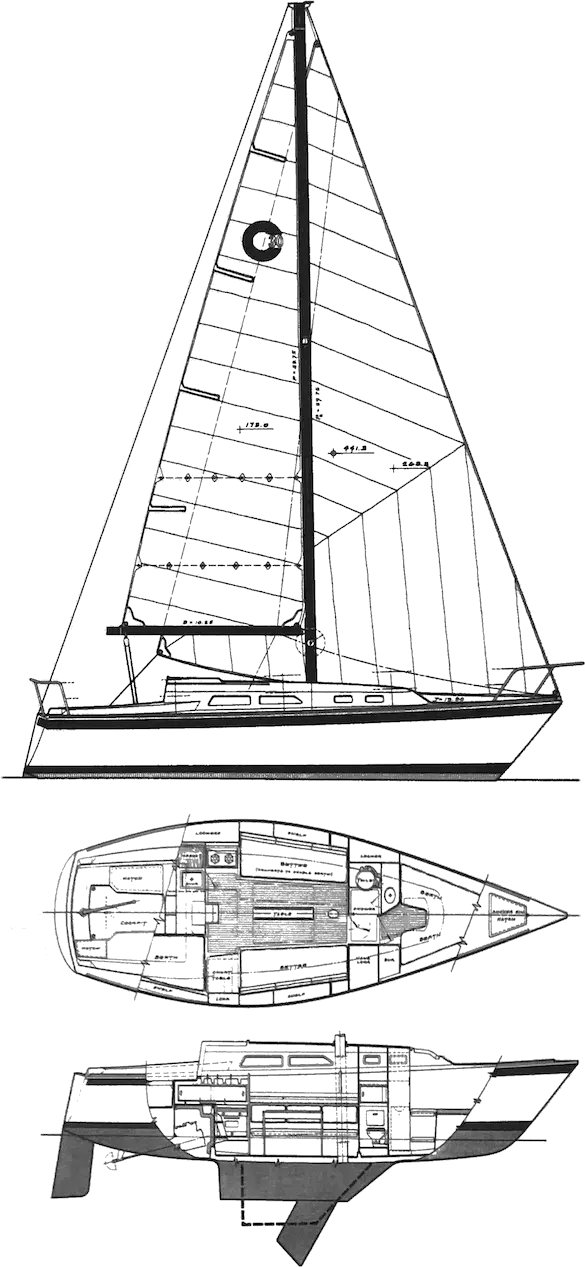
- 2 / 6 Oak Point, TX, US 1983 O'Day 30 $12,900 USD View
- 3 / 6 Oak Point, TX, US 1983 O'Day 30 $12,900 USD View
- 4 / 6 Oak Point, TX, US 1983 O'Day 30 $12,900 USD View
- 5 / 6 Oak Point, TX, US 1983 O'Day 30 $12,900 USD View
- 6 / 6 Oak Point, TX, US 1983 O'Day 30 $12,900 USD View
Rig and Sails
Auxilary power, accomodations, calculations.
The theoretical maximum speed that a displacement hull can move efficiently through the water is determined by it's waterline length and displacement. It may be unable to reach this speed if the boat is underpowered or heavily loaded, though it may exceed this speed given enough power. Read more.
Classic hull speed formula:
Hull Speed = 1.34 x √LWL
Max Speed/Length ratio = 8.26 ÷ Displacement/Length ratio .311 Hull Speed = Max Speed/Length ratio x √LWL
Sail Area / Displacement Ratio
A measure of the power of the sails relative to the weight of the boat. The higher the number, the higher the performance, but the harder the boat will be to handle. This ratio is a "non-dimensional" value that facilitates comparisons between boats of different types and sizes. Read more.
SA/D = SA ÷ (D ÷ 64) 2/3
- SA : Sail area in square feet, derived by adding the mainsail area to 100% of the foretriangle area (the lateral area above the deck between the mast and the forestay).
- D : Displacement in pounds.
Ballast / Displacement Ratio
A measure of the stability of a boat's hull that suggests how well a monohull will stand up to its sails. The ballast displacement ratio indicates how much of the weight of a boat is placed for maximum stability against capsizing and is an indicator of stiffness and resistance to capsize.
Ballast / Displacement * 100
Displacement / Length Ratio
A measure of the weight of the boat relative to it's length at the waterline. The higher a boat’s D/L ratio, the more easily it will carry a load and the more comfortable its motion will be. The lower a boat's ratio is, the less power it takes to drive the boat to its nominal hull speed or beyond. Read more.
D/L = (D ÷ 2240) ÷ (0.01 x LWL)³
- D: Displacement of the boat in pounds.
- LWL: Waterline length in feet
Comfort Ratio
This ratio assess how quickly and abruptly a boat’s hull reacts to waves in a significant seaway, these being the elements of a boat’s motion most likely to cause seasickness. Read more.
Comfort ratio = D ÷ (.65 x (.7 LWL + .3 LOA) x Beam 1.33 )
- D: Displacement of the boat in pounds
- LOA: Length overall in feet
- Beam: Width of boat at the widest point in feet
Capsize Screening Formula
This formula attempts to indicate whether a given boat might be too wide and light to readily right itself after being overturned in extreme conditions. Read more.
CSV = Beam ÷ ³√(D / 64)
A keel/cb model was also available. Draft (board down): 7.18’ / 2.19m Draft (board up): 3.50’ / 1.07m Displacement: 11,000 lbs / 4,990 kg Ballast: 4,700 lbs / 2132 kg
Tall Rig: I: 41.50’ / 12.65m J: 13.50’ / 4.11m P: 35.50’ / 10.82m E: 10.25’ / 3.12m
Reintroduced (with extended stern) as O’DAY 31 (1985). Similar to the RANGER 30.
Embed this page on your own website by copying and pasting this code.

Discover Related Sailboats
- About Sailboat Guide
©2024 Sea Time Tech, LLC
This site is protected by reCAPTCHA and the Google Privacy Policy and Terms of Service apply.

- Forum Listing
- Marketplace
- Advanced Search
- About The Boat
- Boat Review Forum
- SailNet is a forum community dedicated to Sailing enthusiasts. Come join the discussion about sailing, modifications, classifieds, troubleshooting, repairs, reviews, maintenance, and more!
O'Day 30
- Add to quote
O'day made a pretty good coastal cruiser. The 30 would be good for a week or two at sea. I have a O'day 302 and take a 9 day cruise every summer with two friends, one year we stayed on the boat for the entire trip with no problems. You will have to set the boat up for trips longer then a week end but it can be done. You will need nav equipment. Good luck and have fun.
Hello, The O'day line of boats were decent, well made, typical production type boats. Not much different than Catalina, Newport, S2, C&C and the like. The price is good. As long as there survey shows no serious damage, the boat would be fine for your use. It won't be the best boat for going upwind, but it should give you many years of good service. Good luck, Barry
Thanks for the quick replies. Any idea what an eventual conversion to a diesel would cost, installed?
A new appropriately sized diesel will run you as much as you're paying for the boat.....give or take, and depending on what happens with the economy. Yeah.......OUCH! Maybe you'll find a deal for $6500, but I wouldn't think anything less for a new setup. Used? A pull from a wreck? You might get lucky for considerably less. All is not lost with the A4. It has quite the legacy following and improvements have been developed through the years to make them even more reliable. I just read a quote on another thread for an A4 drop-in diesel replacement for a Pearson 10M....$12K. That A4 is looking pretty good right about now, huh?
go O'Day!! Nice sailing boat with a better than average layout below (good storage space, etc.) Make sure you get a mechanical survey/compression check on the A4. It's a great, reliable engine if it's in good shape. Good luck!
I wouldn't hesitate for a moment to buy O'Day (again). The 30 looks like an ideal cruising/weekender type boat. Check the chainplates & hull deck joint.
My family owned a 1980 O'Day 28 for a bunch of years (we bought it new though). As others mentioned, they are about the same quality as other basic production boats of the era. For your intended use (daysailing and weekends), there's no reason it can't be a good boat. While I personally prefer a diesel, but my understanding is that Atomic 4s are reliable if properly maintained. There are online companies that offer parts for A4s, so that should help. Our O'Day 28 had an OMC saildrive, gas engine as well. We never had problems, but our boat was new at the time. The centerboard would have been nice to have when working your way upwind. However, there are plenty of boats that track all right without the boards--I don't have personal experience with the O'Day 30 on that issue. You already mentioned getting survey, which is definitely paramount, even in this price range. As a result of the survey, you may be able to negotiate even more off the price, but most important (in my opinion), you'll know more about the condition of the boat. Knowing what you're getting into will help you witht he decision. Check for moisture in the deck (standard procedure on survey, but can be a problem on O'Days from that era). Others are right that the diesel engine replacement would cost as much as the boat, if not more. If you want to know more about the O'Day 30, there's a review of the boat at Practical Sailor. You have to pay for the review, but it might be worth it. Hope this helps! -J
One thought is if you could find a similar boat with more updates. To sail with family you are going to want a stove, nav equipment, sounder and updated interior (old upolstry can smell as bad as it looks). A reliable motor takes on more importance with kids on board. If you add up the cost of all this you might be better off paying more for a more complete boat and even get the diesel you want. With the economy what it is there may well be a greater supply of good used boats to choose from, particularly in the 30 foot range. Remember that updates like those above will not increase the value of the boat to match what you put into it, so why not find a boat where somebody else has made the initial investment?
Just curious, why would you want a diesel to replace a perfectly good Atomic A4?? It is a very expensive upgrade that will not be recouped if you sell the boat. An Atomic A4 is a simple and relatively bullet-proof engine. As for the swing keel/centerboard being sealed up...that's a minus in my book. The centerboard helps with the boat pointing in deeper waters and helps prevent leeway. Without it, you've got a boat that is shoal draft, but doesn't point very high or well, and tends to sideslip far more than she should. Would highly recommend you read the Boat Inspection Trip Tips thread I posted a while back. It should help you figure out if this boat is worth proceeding further with.
sailingdog said: As for the swing keel/centerboard being sealed up...that's a minus in my book. Click to expand...
The boat was designed as a keel/centerboarder for a reason. The reason was to accommodate a shoal draft while still allowing decent upwind performance. Removing the use of the centerboard makes it a lousy upwind performer... and that can be trouble if you're in a lee shore situation. Also, maintenance on a centerboard isn't all that much. I'd be curious to know how the centerboard trunk was sealed up and why.
sailingdog said: The boat was designed as a keel/centerboarder for a reason. The reason was to accommodate a shoal draft while still allowing decent upwind performance. Removing the use of the centerboard makes it a lousy upwind performer... and that can be trouble if you're in a lee shore situation. Also, maintenance on a centerboard isn't all that much. I'd be curious to know how the centerboard trunk was sealed up and why. Click to expand...
I looked at the boat again today and I'm more and more attracted to it. The interior/cosmetic doesn't seem like a big project. My significant other said she can't wait to make new cushion, etc. (time will tell :laugher ) I appreciate everyone's comment and advice on the Atomic 4. The center board situation is certainly a concern. I plan on going for a sail in the next few days to see how bad (or good) it points without the CB. I guess I'm attracted to the new rigging, spar, sails for that kind of price.
JSailer said: I looked at the boat again today and I'm more and more attracted to it..... The center board situation is certainly a concern. I plan on going for a sail in the next few days to see how bad (or good) it points without the CB..... Click to expand...
I"ve an 82 O-30 with the fin keel. 4'11" draft. 16 hp universal diesel. I love the boat more each year! And I'm going on my 3rd year with her too! If you contact Rudy at D & R marine I think he has a new centerboard keel for your boat. good luck!
I can't tell you how much I appreciate everyone's comments and advice. I made an offer on the boat, subject to satisfactory survey and it was accepted. The survey is scheduled for Wednesday. Then hopefully we'll close the deal and I will leave the boat on blocks and have the bottom paint done. The yard gave me a quote of $900 for the sanding and epoxy bottom paint. Any comments on that? Also, as far as the instruments, I had first written the boat didn't have a depth sounder but it actually has a new Hummingbird fishfinder waiting to be installed and the gentleman was waiting to see where the buyer would want it placed before putting it in. So... my question now is what do you think of putting in a GPS/Depth Sounder unit instead. This way I would only have one unit out there instead of two separate ones. Of course I need to keep the cost down. I found a Lowrance M68C S/Map Fishfinder Chartplotter for $399. Any thoughts?
The yard gave me a quote of $900 for the sanding and epoxy bottom paint. Any comments on that? Click to expand...
I found a Lowrance M68C S/Map Fishfinder Chartplotter for $399. Any thoughts? Click to expand...
I'd keep the two units separate. First, if the single unit fails, you're out two navigation instruments—the GPS and the depthsounder. Second, the screen on the smaller units really can't accommodate both the GPS chart plotting function and the the fishfinding function at the same time.
sailingdog said: I'd keep the two units separate. First, if the single unit fails, you're out two navigation instruments-the GPS and the depthsounder. Second, the screen on the smaller units really can't accommodate both the GPS chart plotting function and the the fishfinding function at the same time. Click to expand...
$900 for basic bottom work is about right, that is what I typically have paid for my 30' boat. Enjoy her, I have done what you have done overall, ie bought a used boat, new cushions, re varnish interior, etc. Takes about 2-3 yrs unless you spend the money right now and have someone do it for you. The 2-3 yrs seems to be ave time from talking with other folks, along with what it took me. And even then, depending upon what you want in the end, as you realize you would like something to be this way vs that way.........you'll be upgrading toying, changing etc for how ever long you have the boat. I would also not be suprised if the CB could be put back in etc. Marty
blt2ski said: $900 for basic bottom work is about right, that is what I typically have paid for my 30' boat. Enjoy her, I have done what you have done overall, ie bought a used boat, new cushions, re varnish interior, etc. Takes about 2-3 yrs unless you spend the money right now and have someone do it for you. The 2-3 yrs seems to be ave time from talking with other folks, along with what it took me. And even then, depending upon what you want in the end, as you realize you would like something to be this way vs that way.........you'll be upgrading toying, changing etc for how ever long you have the boat. I would also not be suprised if the CB could be put back in etc. Marty Click to expand...
Congratulations sounds like you got your "work" cut out for youself, its a good way to learn about the systems have fun on your new boat.
JSailer said: Hello, First, I want to apologize if this has been answered before in some way but I searched for a while and cold not find anything on this... So here we go. I am looking at buying my first boat. I have sailed most of life on a variety of boats but never owned one. This boat is to be used on the East coast of Florida for day sailing and light cruising to the keys and maybe eventually to the Bahamas if appropriate. Two adults and 3 younger boys (5, 7, 9). So... Now that I have bored you to death with my pedigree, the real question comes regarding this 1978 O'Day 30 I'm looking at. Asking $8500. New mast, boom, standing and running rigging, mostly new sails, spinaker, etc. QUOTE] Do you know the reasons why the mast and boom have been replaced? Was it just normal wear or was there some sort of unfortunate event? Click to expand...
Do you know the reasons why the mast and boom have been replaced? Was it just normal wear or was there some sort of unfortunate event? Click to expand...
Interesting set up. It seems simple enough... Thanks.
The wall covering was the first thing to come out. Old and dirty. So now the question is, what do I replace it with? This was a vinyl type of material with a thin foam padding. I don't have to get the same stuff. Any advice? Should I stick to a vinyl material? Is regular fabric a no-no because it would hold moisture?
I like the paneling idea. I saw it in a magazine and it looked beautiful, but it might be a bit more work than I want to do. I looked at some Redrum fabric sold at West Marine ( West Marine: Marine Headliner/Hull Liners Product Display . I believe it runs about $30 a foot. Is that stuff worth that much or does anyone know if there is comparable products at non-marine store?
Before you start replacing the wall fabric consider fixing all your stanchion base leaks! The bolts are nearly impossible to reach with double jointed fingers. The fabric was glued on the outer edge of the ceiling liner along the back of the rub rail. If you look you will most like see lots of friendly black mold there also!
Yes, I have found some black spots... Thank you for the advice. I will get on that tomorrow.
- ?
- 174K members

Top Contributors this Month
O'DAY 30 Detailed Review
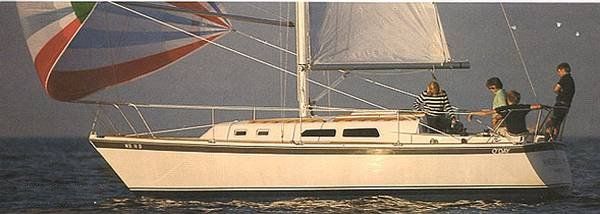
If you are a boat enthusiast looking to get more information on specs, built, make, etc. of different boats, then here is a complete review of O'DAY 30. Built by O'Day Corp. and designed by Raymond Hunt (C.R. Hunt & Assoc.), the boat was first built in 1977. It has a hull type of Fin w/spade rudder and LOA is 9.12. Its sail area/displacement ratio 14.78. Its auxiliary power tank, manufactured by Universal, runs on Diesel.
O'DAY 30 has retained its value as a result of superior building, a solid reputation, and a devoted owner base. Read on to find out more about O'DAY 30 and decide if it is a fit for your boating needs.
Boat Information
Boat specifications, sail boat calculation, rig and sail specs, auxillary power tank, accomodations, contributions, who designed the o'day 30.
O'DAY 30 was designed by Raymond Hunt (C.R. Hunt & Assoc.).
Who builds O'DAY 30?
O'DAY 30 is built by O'Day Corp..
When was O'DAY 30 first built?
O'DAY 30 was first built in 1977.
How long is O'DAY 30?
O'DAY 30 is 7.75 m in length.
What is mast height on O'DAY 30?
O'DAY 30 has a mast height of 10.29 m.
Member Boats at HarborMoor
O'day 30
The o'day 30 is a 29.92ft masthead sloop designed by hunt & associates and built in fiberglass by o'day corp. between 1977 and 1984., 356 units have been built..
The O'day 30 is a moderate weight sailboat which is slightly under powered. It is very stable / stiff and has a good righting capability if capsized. It is best suited as a coastal cruiser. The fuel capacity is originally small. There is a very short water supply range.
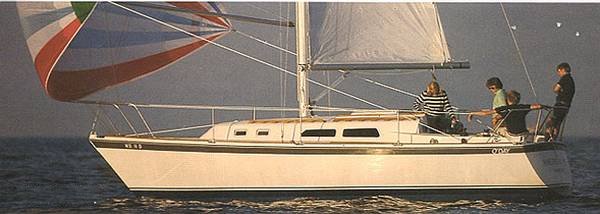
O'day 30 for sale elsewhere on the web:

Main features
Login or register to personnalize this screen.
You will be able to pin external links of your choice.

See how Sailboatlab works in video

We help you build your own hydraulic steering system - Lecomble & Schmitt
Accommodations
Builder data, other photos.
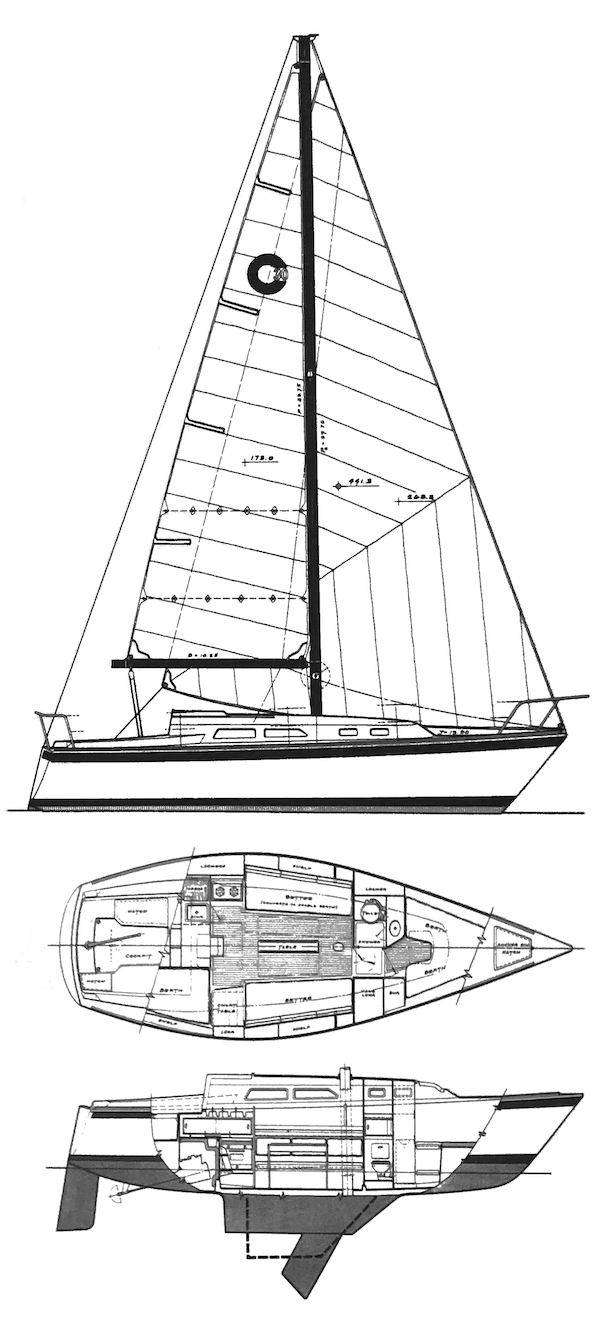
Modal Title
The content of your modal.
Personalize your sailboat data sheet

Are O’day Sailboats Any Good? (Here’s What You Need To Know)

Sailboats have been used for centuries to explore the world’s oceans, lakes, and rivers.
Whether youre a beginner or an experienced sailor, an O’day sailboat may be the perfect choice for you.
In this article, we’ll explore the advantages, types, performance, durability, affordability and uses of O’day sailboats.
We’ll also look at some of the considerations you should take into account when deciding if an O’day sailboat is right for you.
So if youre looking for a reliable, affordable, and versatile sailboat, read on to learn more about O’day sailboats.
Table of Contents
Short Answer
O’Day sailboats are generally well-regarded for their quality and performance.
They have been in production since the 1960s and incorporate modern designs and materials to ensure excellent sailing performance.
The quality of the craftsmanship is reliable and the boats are known for their comfort and ease of use.
O’Day sailboats are a great choice for beginner and experienced sailors alike.
Overview of O’day Sailboats
O’day sailboats are a popular choice among sailing enthusiasts for good reason.
They offer a great combination of performance, durability, and affordability.
The vessels feature an easy-to-use design, with plenty of options to choose from for both recreational sailing and racing.
O’day sailboats are generally known for their stability and speed, and the smaller models are perfect for beginner sailors.
The boats are also very durable, making them a great choice for those looking for a reliable and affordable vessel.
In addition, O’day sailboats are easy to maintain and repair, and are available in a variety of styles and sizes.
From larger vessels suitable for coastal sailing to smaller boats perfect for lake sailing, O’day sailboats have something for everyone.
With their wide range of features and benefits, O’day sailboats are a great choice for those looking for an enjoyable and affordable sailing experience.
Advantages of O’day Sailboats

When it comes to sailboats, there are many different options available and O’day sailboats are one of the most popular choices.
O’day sailboats provide a great balance of speed and stability, making them a great choice for both recreational and competitive sailors alike.
O’day sailboats are also known for their durability and affordability, making them a great choice for those looking for a reliable and budget-friendly vessel.
One of the biggest advantages of O’day sailboats is their performance.
These boats offer excellent performance, allowing sailors to take on challenging conditions with ease.
They are also designed with an easy-to-use layout, making them accessible to beginner sailors.
O’day sailboats are also known for their variety of options, allowing sailors to choose the perfect boat for their needs.
Another great advantage of O’day sailboats is their durability.
These boats are built to last, providing sailors with a reliable vessel that can handle the toughest conditions.
O’day sailboats are also known for their affordability, making them a great choice for those looking for an affordable boat.
Lastly, O’day sailboats are a great option for those looking for a reliable and affordable vessel.
Whether for recreational sailing or racing, O’day sailboats are a great choice for those looking for a reliable and affordable vessel.
Types of O’day Sailboats
O’day sailboats come in a variety of sizes and designs, making them a great choice for sailors of all levels and abilities.
From smaller, more beginner-friendly models to larger racing vessels, there is an O’day sailboat for everyone.
The most popular models include the O’day Mariner, O’day Daysailer, O’day Javelin, and the O’day Rhodes 19.
The O’day Mariner is a great choice for those just starting out in sailing, as it is smaller and easier to handle.
It is also lightweight, making it perfect for daysailing and light cruising.
The O’day Daysailer is a great choice for those looking for a larger sailboat with a more traditional look and feel.
It is perfect for recreational sailing and daysailing.
The O’day Javelin is an ideal choice for racers, as it offers excellent performance and speed.
It is light and easy to maneuver, making it great for competitive sailing.
Finally, the O’day Rhodes 19 is a great choice for those looking for a larger sailboat.
It is known for its durability and reliability, making it perfect for long-distance sailing.
No matter what type of sailing you are interested in, O’day sailboats are an excellent choice.
With a variety of models to choose from, there is an O’day sailboat for everyone.
From smaller beginner-friendly models to larger racing vessels, O’day sailboats provide a great balance of speed, stability, durability, and affordability.
Performance and Stability of O’day Sailboats

When it comes to performance and stability, O’day sailboats have a lot to offer.
The vessels are designed to be fast and agile, making them perfect for a variety of sailing styles.
The boats are also designed with stability in mind, which makes them an excellent choice for both beginner and experienced sailors.
With their wide beam and large keel, O’day sailboats provide great stability in a variety of conditions.
The boats are also incredibly durable, making them ideal for long-term use.
Additionally, the boats are designed to be easy to maneuver, allowing for quick changes in direction when needed.
O’day sailboats are a great choice for those looking for a reliable and responsive boat that can handle a variety of sailing conditions.
Durability and Affordability of O’day Sailboats
When it comes to sailboats, durability and affordability are two of the key factors to consider.
O’day sailboats offer both of these features, making them a popular choice among sailing enthusiasts.
The hulls of O’day sailboats are constructed from a lightweight yet strong fiberglass material, which helps them to last through years of use.
Additionally, the sailboats are designed with an efficient and streamlined shape, which helps to reduce drag and improve performance.
When it comes to affordability, O’day sailboats are one of the most cost-effective options on the market.
The sailboats offer a variety of models to choose from, which makes it easy to find one that fits your budget.
Additionally, the boats come with a variety of features and options that can be customized to meet your needs.
This makes the sailboats a great choice for those looking to get the most value for their money.
Overall, O’day sailboats offer a great combination of durability, affordability, and performance.
With their lightweight yet strong construction, efficient design, and variety of features, O’day sailboats are an excellent choice for those looking for a reliable and affordable vessel.
Whether you’re looking for a recreational sailing boat or a competitive racing boat, O’day sailboats are a great option that won’t break the bank.
Uses for O’day Sailboats

ODay sailboats are incredibly versatile vessels, making them ideal for a variety of uses.
Whether youre a recreational sailor, a competitive racer, or looking for an economical and reliable boat, ODay sailboats are an excellent option.
For recreational sailing, ODay sailboats offer both speed and stability.
Their lightweight construction and easy-to-use design makes them ideal for beginner sailors.
They also come in a variety of sizes, from small day-sailers to larger boats that can be used for week-long trips.
For racing, ODay sailboats offer excellent performance and maneuverability.
Their lightweight construction makes them fast and nimble, and theyre known for their ability to handle rough and choppy waters.
ODay sailboats are also popular in competitive sailing circles, as they are reliable and affordable.
Lastly, ODay sailboats are known for their durability and affordability.
The boats are designed to withstand the rigors of sailing, and are made with quality materials that will last for years.
They are also very affordable, making them a great option for those looking for a reliable and economical vessel.
Overall, ODay sailboats are an excellent choice for anyone looking for a reliable and affordable vessel.
They offer a great balance of speed and stability, and are known for their durability and affordability.
Whether youre looking for a recreational vessel or a competitive racer, ODay sailboats are a great option.
Considerations for Buying an O’day Sailboat
When considering purchasing an Oday sailboat, there are several important factors to keep in mind.
First, budget is a major consideration.
Oday sailboats are typically more cost-effective than other sailboat models, but the features and size of the vessel can greatly affect the final price.
Second, consider the performance characteristics of the boat.
Oday sailboats are known for offering excellent performance, but you may want to consider the size and weight of the boat and the type of sailing you plan to do before making a purchase.
Third, consider the ease of use of the boat.
Oday sailboats are designed for easy handling and come with a variety of options to choose from.
Finally, consider the durability of the boat.
Oday sailboats are known for their ruggedness and reliability, but certain areas of the boat may need more frequent maintenance than others.
Doing your research and considering all of these factors will help ensure that you make the best decision when selecting an Oday sailboat.
Final Thoughts
ODay sailboats offer a great balance of performance, stability, durability, and affordability, making them an excellent choice for all levels of sailing.
Whether youre looking for a recreational sailboat or a competitive racing vessel, ODay sailboats provide a great range of options to suit your needs.
If youre considering buying an ODay sailboat, consider the type of sailing youll be doing, the size of the vessel, and the features and options youll need.
With the right research and some careful consideration, you can find the perfect ODay sailboat for your sailing needs.
James Frami
At the age of 15, he and four other friends from his neighborhood constructed their first boat. He has been sailing for almost 30 years and has a wealth of knowledge that he wants to share with others.
Recent Posts
Does Your Boat License Expire? Here's What You Need to Know
Are you a boat owner looking to stay up-to-date on your license requirements? If so, youve come to the right place! In this article, well cover everything you need to know about boat license...
How to Put Skins on Your Boat in Sea of Thieves? (Complete Guide)
There is a unique sense of pride and accomplishment when you show off a boat you customized to your exact specifications. With Sea of Thieves, you can customize your boat to make it look like your...
Boat Profile
O’Day Day Sailer
A proven performer for 61 years
From Issue July 2019
T he production of small boats was booming in the 1950s on both sides of the Atlantic, and really took off in the late ’50s with the introduction of fiberglass. Famed designers Uffa Fox and George O’Day teamed up in 1956 to create the O’Day Day Sailer. Fox is credited with introducing the technique of planing to dinghy racing and designed many significant classes of boats, including the International 14. The story goes that Fox wanted a pure racing dinghy but O’Day wanted the small cuddy added to increase appeal to the recreational market in the U.S., so Fox designed the planing hull and O’Day designed the cuddy. The resulting Day Sailer was a 16’9” centerboarder with a displacement of 575 lbs, which makes for a light load to tow behind the family car. The fractional sloop rig includes a generously sized spinnaker for exciting downwind sailing.
The first Day Sailer was sold in 1958 and immediately became popular in the recreational and racing markets. It was later designated as the Day Sailer I as four different models have since been built, with over 10,000 boats hitting the waterways. Day Sailer (DS) models I through III have been built by eight different manufacturers, with the current Day Sailer being a modified DS I with a few DS II attributes, such as the internal foam flotation and cuddy thwart. The original DS models I, II, and III were built from 1957 to 1990 by the O’Day Company in Fall River, Massachusetts. The DS I and modified versions of it were later built by Can-AM Sailcraft, Rebel, Spindrift, Precision, McLaughlin, Sunfish/Laser Inc. The current builder of the DS I+ is the Cape Cod Shipbuilding Company (CCSC) in Wareham, Massachusetts, holder of the exclusive license since 1994. The Day Sailer Class Association owns the molds that are currently used by CCSC.
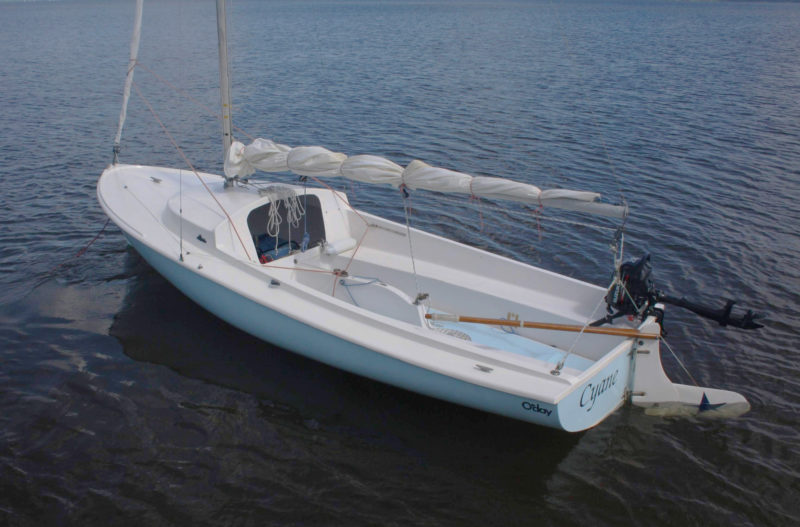
The long side benches in the cockpit provide uncrowded seating for six. The sole is above the waterline and is self-bailing.
The early DS I can be identified by wooden thwarts, seats, and cockpit sole, a centerboard lever, open cuddy, and a transom deck. The DS II came out in 1971 with built-in foam flotation. The cuddy opening is smaller than the opening on the DS I because it also acts as a thwart, and a thinner transom allows mounting a small outboard motor without the need for a bracket. The Day Sailer I and II are considered class legal for one design racing, but the DS III is not considered race-legal due to higher freeboard on the transom, which was a departure from Fox’s hull design. O’Day built the III from 1985 to 1990, so to race in One Design regattas it is important to buy a DS I or DS II. The current Day Sailer in production is a modified version of the DS I with improved self-rescuing capabilities, two sealed air tanks, and a cuddy flotation tank with a smaller hatch.
The Day Sailer, no matter which model, is a very versatile boat, easy to rig, sail, transport, and store. With the mast down the boat and trailer take up just a few feet more than an average family car, so can be stored in most garages, though the mast may need to be stowed diagonally. At the ramp, the Day Sailer can be rigged in under 30 minutes: step the mast, add the boom, bend on the jib and main, clip the pop-up rudder onto the transom, and sort out the sheets.
Stepping the mast is the biggest challenge. The 23′4″-long racing mast is stepped through the top of the cabin onto the maststep fixed to the floor of the cuddy, and that can be tricky for one person. The mast does not weigh much, but it is helpful to have a helper at the foot of the mast to guide it into the cuddy opening. The good news with this arrangement is that once the mast is stepped, it is secure, and there’s no rush to attach the forestay.
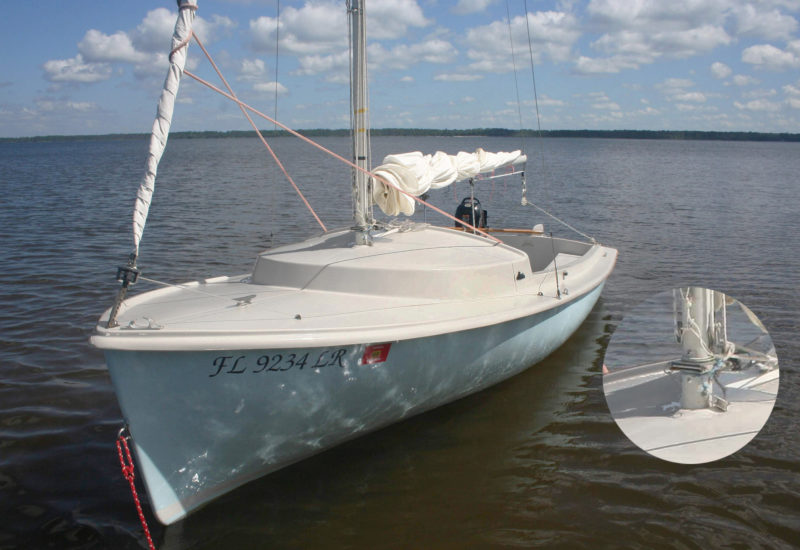
A mast hinge, a popular option, makes raising the mast much easier.
About 75 percent of the new boats are delivered with a hinged mast, eliminating the awkward gymnastics of stabbing the mast through the cuddy. Once the mast is raised and the forward hole on the hinge pinned, securing the forestay to the bow fitting takes the strain off the hinge. Side stays can then be tightened to take out the slack, but no more than hand tight. Stays that are too tight can damage the hull. Tighten the nuts on the turnbuckles and tape over any cotter pins.
There are different sheeting arrangements for the boom. Some boats have sheets attached in the middle of the boom; the sheet on a DS II starts from a traveler on the transom and ends forward on a swivel cam cleat mounted to the centerboard case. The DS II boom also has a spring in the gooseneck that allowed for roller furling— disconnect the sheet, pull the boom aft, and roll the sail onto the boom. A reefing claw has to be added to connect the sheet to the sail-wrapped boom, but this design is not optimum, nor is the wad of rolled-up sail by the boom’s gooseneck. A better arrangement is to add a conventional set of reefpoints to the mainsail. The boom also has a vang to improve sail control.
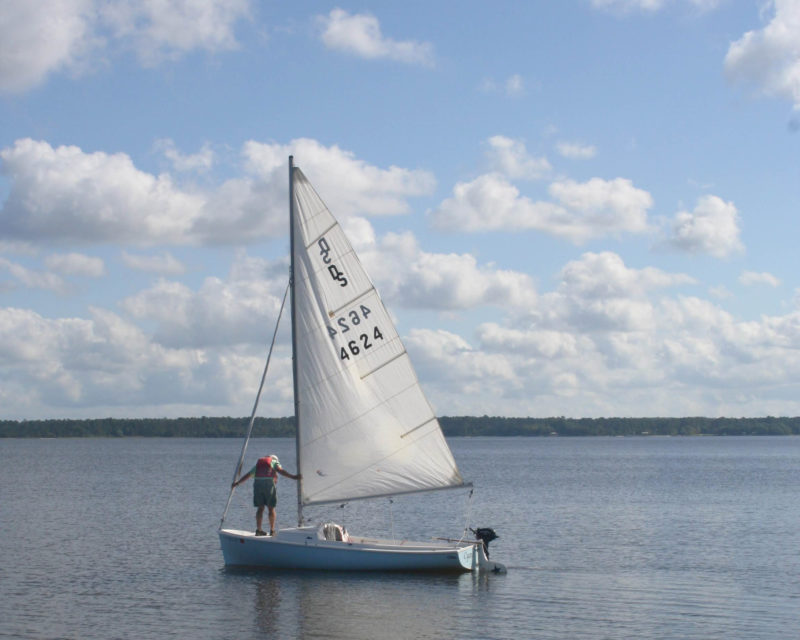
The 6′ 3″ beam gives the Day Sailer good stability, enough to keep the boat under someone standing on the foredeck.
The jib on the racing version of the DS is a standard affair, attached with hanks onto the forestay and raised with a halyard. Some skippers add a downhaul to lower the jib from the cockpit. Both the main and jib halyards are led aft on the top of the cuddy. The recreational version of the new DS I comes with a roller-furling jib, which we consider essential for sailing dinghies, especially if singlehanding. We have added a roller-furling jib to our DS II along with the mast hinge. We also added the hardware and rigging for a spinnaker, halyard, spinnaker pole, spinnaker pole control lines, sheet blocks, and jam cleats.
T he Day Sailer is a treat to sail; it handles well, tacks with ease, and powers up quickly with its large sail area. The planing hull is responsive to the tiller, and the wide beam makes it stable. The boat will roll quickly but then sets on a tack, holding it with stable and positive helm control. The centerboard can be easily adjusted from amidships.
We sail a Drascombe Lugger and a Sunfish; the Lugger drives like the family sedan and the Sunfish like our Mustang. The Day Sailer handling is closer to that of the Sunfish—when the breeze picks up, the mainsheet needs to be held in the hand and someone should be ready on the jibsheets. The jibsheets run through the coaming on the DS I and through small cars on the DS II. For the highest performance, skippers have added tiller extensions and hiking straps. There is an outhaul on the battened main; racing versions have barber-haulers and travelers added. Pop the spinnaker, and it will scoot along quite nicely in a light breeze.
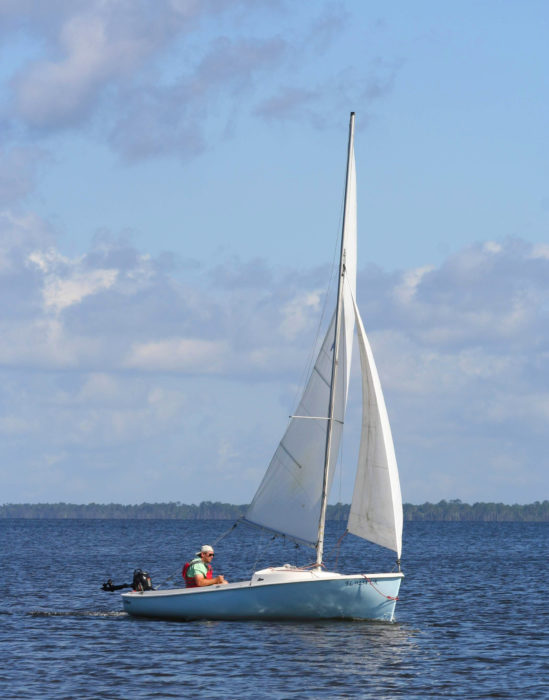
The Day Sailer carries 100 sq ft in the main, 45 sq ft in the jib and, for sailing off the wind, another 95 sq ft in spinnaker.
The Day Sailer’s 7′ 4″-long cockpit provides plenty of room for three adults, or two adults and two kids. With four adults it gets cozy; there is not much moving around, so whoever is sitting next to the tiller or foredeck needs to know what to do. It is easy to depower the main, reef it, or furl the jib as needed.
The cuddy is spacious for storing picnic or camping gear, and it affords a space equivalent to a two-person backpacker tent for sleeping aboard for overnight cruising. Adding a topping lift makes the boom nice ridgepole for a boom tent; there’s plenty of room to sleep in the uncluttered cockpit. The Day Sailer has completed many endurance cruising events, such as the Texas 200, Florida 120, and the Everglades Challenge.
A small kicker can be added for auxiliary power. We have used both an electric trolling motor and gas outboard, with best results coming from a 2-1/2-hp four-stroke that pushed push the boat to 6 knots at one-third throttle. The DS I will require a bracket to support and outboard; the DS II transom is thin and sturdy enough for a direct mount. If we’re not going far from home, we occasionally skip the outboard and carry a paddle; with her low coaming we have paddled her a bit, even backward over the transom.
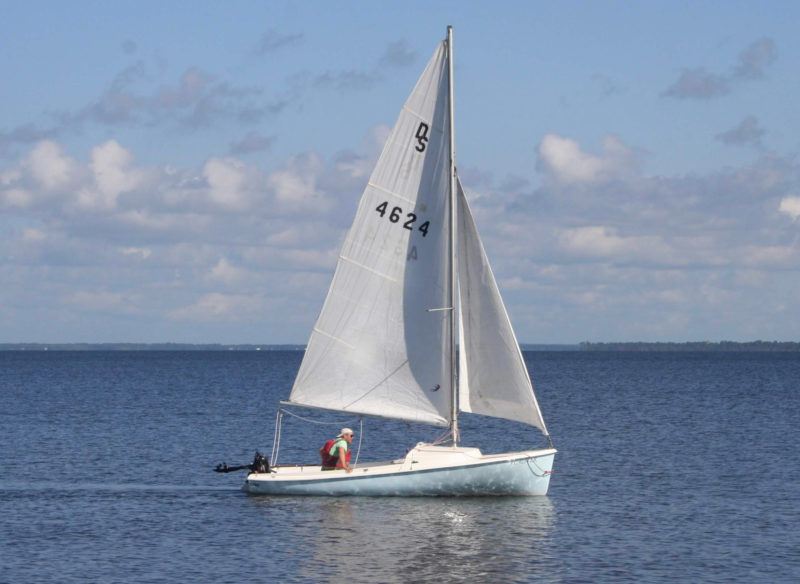
The transom of the Day Sailer II will accommodate an outboard for auxiliary power. The Day Sailer I will require a bracket.
D ay Sailers are easy to find and inexpensive, considering their capabilities. If you come across one, there are few important things to check. Make sure the centerboard moves in the trunk, see that the forestay tang and bow seam are not pulled up, inspect the cuddy deck for noticeable depression which would indicate failure of the maststep under the cuddy floor, and if it is a DS II look inside the flotation compartments. Rinse her off and get her ready to sail. There is a great Day Sailer Association with a web-based forum, and excellent parts availability.
Audrey and Kent Lewis enjoy time with CYANE, along with their small fleet of kayaks, canoe, sailboats, and lapstrake runabout. They blog about their adventures on smallboatrestoration.blogspot.com
Day Sailer Particulars
Length/16′ 9″
Draft, board up/9″
Draft, board down/3′ 9″
Displacement/575 lbs
Main/100 sq ft
Jib/45 sq ft
Spinnaker/96 sq ft
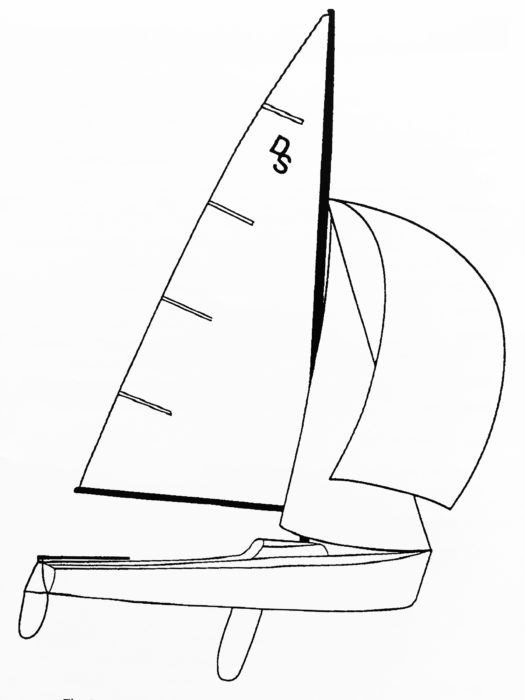
The Day Sailer is built by Cape Cod Shipbuilding Company . Prices start at $18,335 (less sails). For more information about the Day Sailer Class, visit the Day Sailer Association .
Is there a boat you’d like to know more about? Have you built one that you think other Small Boats Monthly readers would enjoy? Please email us!
Share this article
Join The Conversation
We welcome your comments about this article. If you’d like to include a photo or a video with your comment, please email the file or link.
Comments (35)
Great article Kent! I have a sister to your boat, right down to the racing mast and blue hull!! But since we’re moving to the Pacific NW, I’m about to sell it. I’m limiting myself to only 3 boats for the move (and it’s a hard sorting out!!!!). Great write-up about a fantastic boat! Thanks! Charlie
My father was George O’Day. It is nice to know the basic design that my Dad helped create is still vibrant 60 years later. I always find it interesting since Dad was a pure racing sailor that he designed a boat and saw the importance of appealing to the recreational aspect of sailing. He wanted to open the door to the bigger audience to share his passion of sailing.
I sailed with your father on a Hobie 16 at a Red Cross small craft instructor program. So much fun sailing with a legend.
Charlie we know it’s hard, the Day Sailer is such a timeless boat. If she has to change skippers, find her a good one.
Miss Beth, so wonderful to hear from a family member, it must have been quite an adventure to grow up around boating and racing. That Day Sailer hull was Cap’n Jack’s favorite, we enjoyed looking at it. Thank you for the insight into your family’s history.
Cheers, Skipper and Clark
I’ve had an O’Day for years, my first sailboat. I love sailing her around our little lake.
This boat is the best for a small family. In Brazil it’s a great option.
O’Day DS was my first brand-new boat. I was a “veteran”of maybe six months sailing in the late 1960s and she taught me to love sailing.
Great boat design. I’ve sailed different ones on and off over the years. Still a favorite.
Beth, your father made great boats as my father still has an O’Day 20 he bought new in ’76 and it’s still like new and a great sailing boat!
I recently bought a 1966 model after downsizing from a Viking 28. My father owned a Rhodes 19 and we sailed that boat for years on the western end of Lake Ontario. The design was similar, so the transition to the 16 was easy. I love the boat because even in high winds I can make a simple adjustment to the main with reef points. Solo sailing is fun and safe. I can see why so many were sold.
Hello, I just bought O’day sailboat. I do believe from what I’ve been reading that it’s a Daysailer 1. I was told this boat has never been registered and never had a kicker motor on it, I can’t find the metal tag on the transom but I see the two rivet holes where it should have been. Is there any other place on this boat to find the serial number? I would like to put a kicker on it and register it and, if not, is there a way to register this boat? Thank you for helping
The requirements to register a small boat that has not been registered before is different for each state. In NY, a boat is registered through the DMV. HIN numbers are placed on the right side of the transom. If you do not have one your boat was made prior to 1972.
Thank you for the reply, I’m working on getting a HIN number now.
Check with O’Day. Some manufacturers hide a second HIN onboard. Worth a shot.
My boat has a plate on the inside toward the front of the boat. On the bulkhead (might not be the right term) behind the mast. You’ll have to crawl into the cubby to see it. It’s a little plate 2″ x 4″ and shows Hull no. and Class no. The paperwork I have says the boat was made in 1967. Does anyone know the difference between Hull number and Class number?
Can anyone give me today’s value of a 1960 O’Day Day Sailer, #333, with a small motor that goes on the mount with sails that all sit on a Dilly trailer? It has all the original woodwork that my husband redid. It does not have a spinnaker but has the jib and main and a Proctor mast.
My daughter and I are looking for an older (less expensive) sailboat. Not sure where your at , we are South of Boston. The O’Day is our first choice. If you are going sell, please reply to this comment. Thanks
[I’ll connect sellers to John. Ed.]
16′ O’Day Day Sailor with trailer and motor
2013 DS for sale in Sharon,MA. needs work on floatation tanks
At 30 years old, I just bought my first sailboat which is a 1965 DS I. The boat has sat for a few years and she needed a good power-washing plus painting of the hull and inside the cubby and several new lines. I’m completely inexperienced with sailing (plenty of time cleaning boats, though) and couldn’t be happier to learn on such a beautiful vessel. Thanks for this article! It’s great to get some background info. Plus, plenty of words to highlight as I expand my boating vocab.
Day Sailers are easy to find? I guess you know where to look (certainly no offers in Craigslist). I have not been lucky enough to come across a good one that is 10 to 20 years old. I live in Massachusetts. Would you mind sharing where to look for one?
I have an O’Day day sailer 16.5 ‘ up for the taking. Our family had years of good times sailing and camping with It. Great family boat. Wooden seats and rails. Needs some work. In central Massachusetts
I am assuming you have gotten rid of your O’Day day sailer – if not, I may be interested. I’m new to sailing at 57 years young! I just took lessons at KYC here in Blue Hill, ME and am looking for a great starter boat that I can learn in and have fun on the bay.
Thanks, Kelly
Actually, I just bought a 1989 DS2 from Craigslist, on trailer, for $300. It needs only minor work and a lot of cleaning. I hope to float it Saturday to see if it sinks like a rock (I know it has flotation), and will need glass work, but I could see nothing amiss while on the trailer.
So, never say never.
Hi Laranja, I just read your comment about trying to find a used O’Day Day Sailer. I live in Wareham where Cape Cod Shipbuilding is located, they are the current builders of the Day Sailer. They usually have used boats available. I have a 1971 DS, a wonderful boat.
I have a 2013 DS for sale in Sharon,MA. needs work on floatation tanks
Fantastic article
Interested in purchasing a fine example that was actively sailed
I agree with the many positive comments above. Great article! I was a longtime owner of an O’Day Widgeon (14′), and after many boat-less years I’m pleased to have purchased a 1984 O’Day Daysailer II just last week. It’s in good condition, and after sourcing a few needed part, I’ll enjoy it on lakes here in Georgia. Thanks for the great article, which has served as an orientation of sorts for me as to what to expect when I launch her for her maiden voyage under my ownership. A long-time marketing and sales executive, I’m naming her SAILS CALL!
I just got a DaySailer, thought it was a 67 DS1 but the transom is thick with a box on the port side by the transom so not sure now DSII?
I just today bought and brought home to MA a 1966 O’Day Day Sailer (as shown on the registration from NH), and it has a thick transom with lidded box on the port side. Also has a wide cuddly opening and wooden cowling and thwarts as described above for a DSI.
We’re down sizing from a 53′ Pearson to an O’Day 18 that someone offered us. I have no qualms about the sailing, but the temperature of the water here (Massachusetts to Connecticut) worries me very much, after a lifetime in the tropics. Are these dry boats when sailed conservatively?
I have a 2013 Cape Cod built DS for sale in MA. Needs some work on floatation tanks.
I just sold our Venturer 22 and picked up (rescued) an O’Day 16 DS. A couple weeks in the shop and it looks ready to sail. One question: the roller reefed main (boom) does not “lock in.” I suppose I could jiffy reef it but does anyone have experience with the roller reefing boom? Am I missing a part (the claw) or do I just not get it.
I want to buy an O’Day sail 17′
We have a 1976, 17′ foot O’Day DSll (?) on trailer that we are transferring to another family member. We are trying to figure out the best way to get it from Oregon to New Hampshire. Any ideas out there?
Leave a Reply Cancel reply
Your email address will not be published. Required fields are marked *
Stay On Course
More From This Issue

From The Editor
Suitable for Framing
here’s an interesting exhibition of art at the Georgetown Historical Society in Georgetown, Maine. Some of the pieces on display are an unusual pairing of abstract painting and wooden boat...
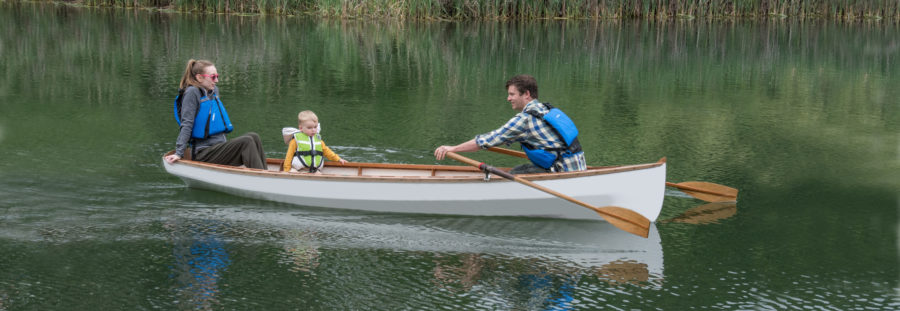
Whitehall Tender
Shenandoah Whitehall
The construction went quickly. Every major project I’ve ever begun has a hidden “gumption trap”—a difficult and unrewarding challenge that sucks the will to persist right out of me. This…

The Day Sailer, no matter which model, is a very versatile boat, easy to rig, sail, transport, and store. With the mast down the boat and trailer take up just…
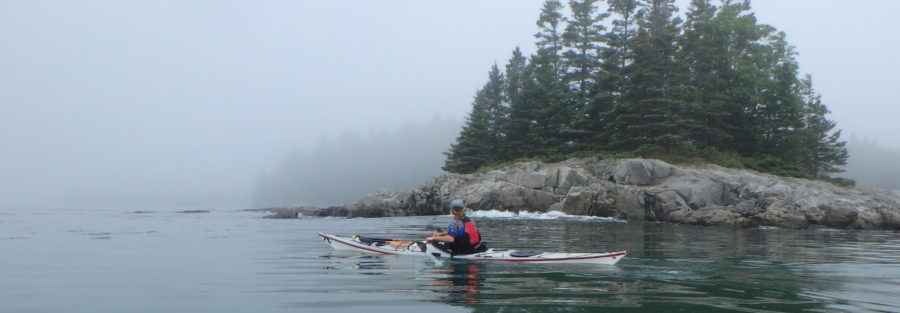
Dallying Downeast
We’d started at Deer Isle, where we had lived and worked for 14 years, and we planned to paddle a big figure-eight: first down to Portland and back, and then…
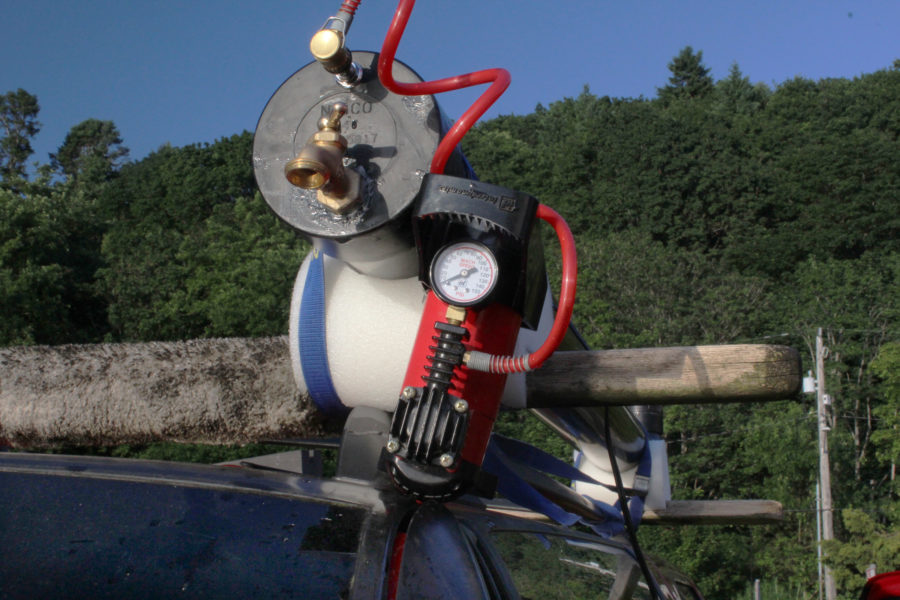
A Cartop Water Tank
Bringing the pressure up to 40 psi is sufficient to propel the remaining 4 gallons of water out of the tank. The nozzle I have on the hose will shoot…
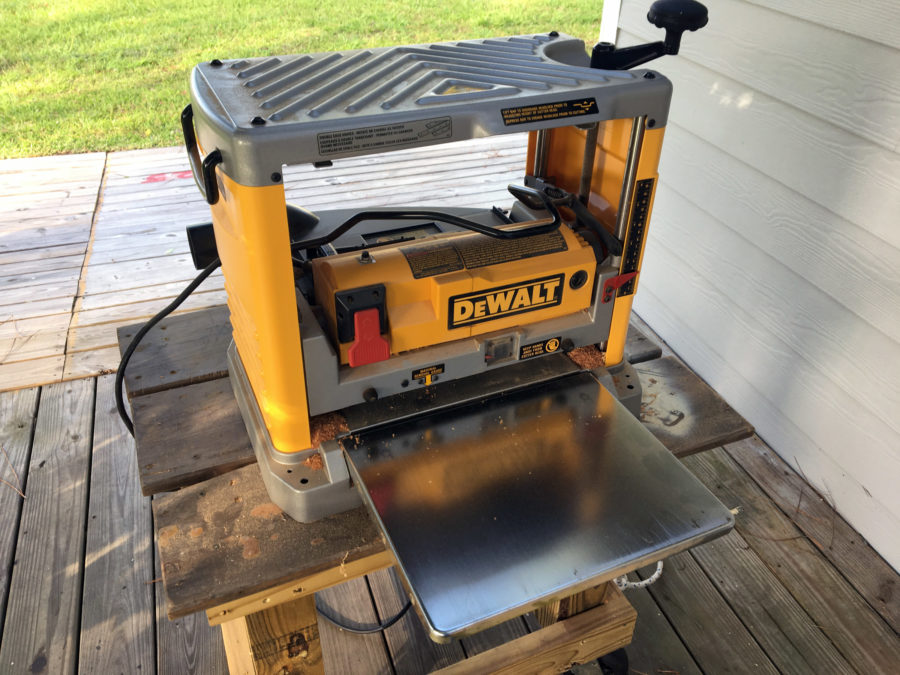
Product Reviews
DeWalt’s Benchtop Planer
We researched benchtop planers and decided the DeWalt DW734 would meet our requirements. Its 12-½” wide bed could handle the 12”-wide garboard that we needed to replace, and its 6”…
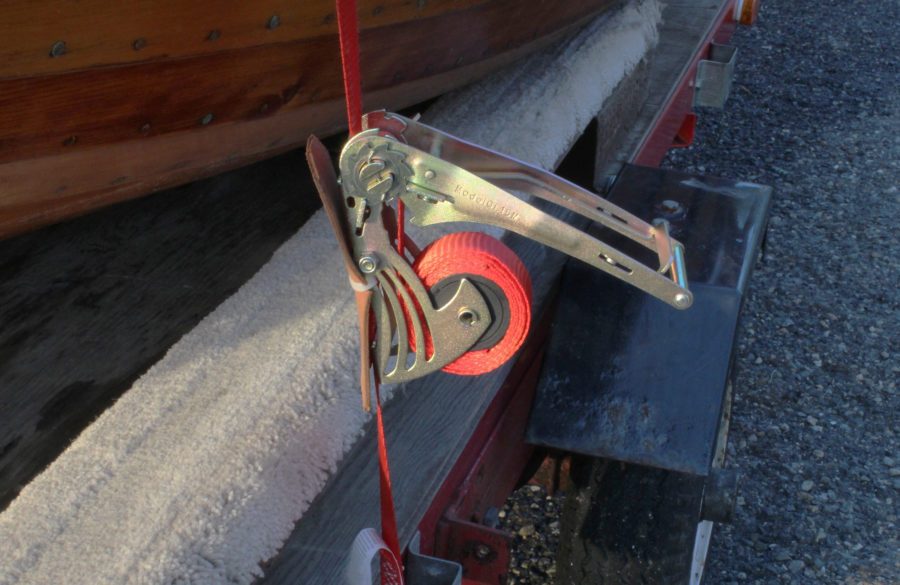
Quickloader Retractable Ratchet Straps
The QL15 model has two black, rubber-coated metal S-hooks, one of which is on a 9-1/2” piece of 1” polyester webbing, and the other is at the end is a…
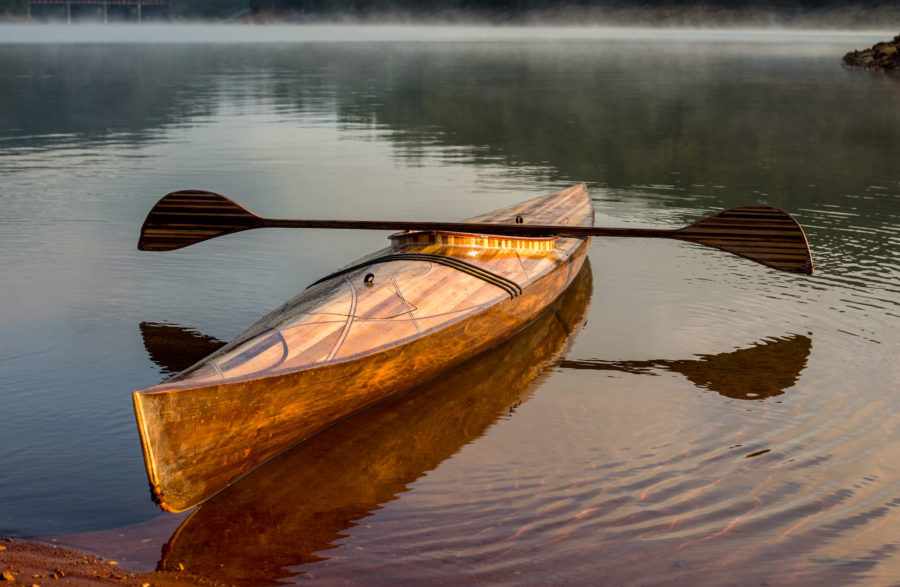
Reader Built Boats
DREAM WEAVER
Neither Claudia nor Jacob came into that class with much experience in marine design beyond scanning online videos and blogs. For guidance on construction they studied Nick Schade’s The Strip-Built…
More Boat Profile
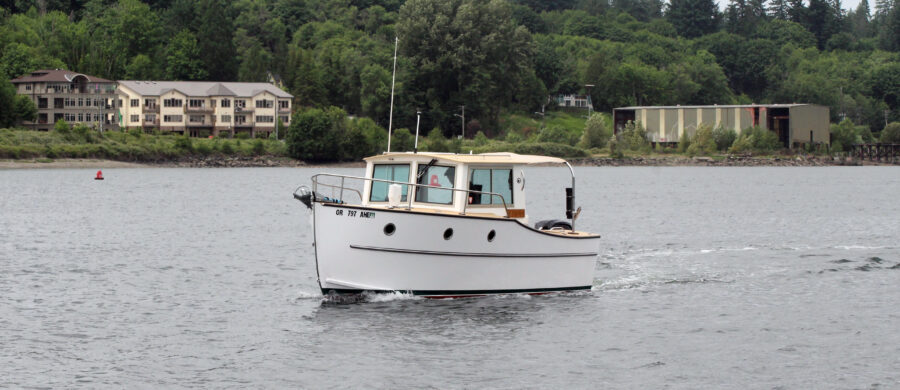
Before Sam Devlin fired up the motor and backed BANJO from the dock, the two of us relaxed in the cabin and chatted about boats each of us had designed…
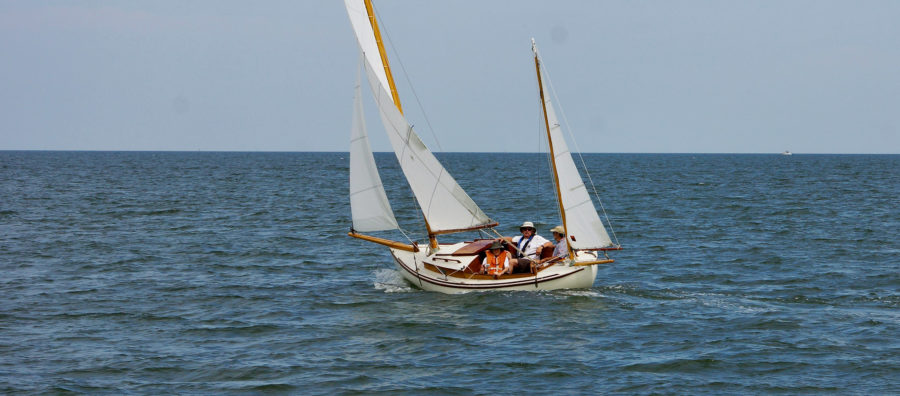
When I sail WINKLE, my William Garden–designed Eel, people almost always take out their cameras. The 18′6″ canoe yawl was designed as a slightly shorter and much lighter version of…
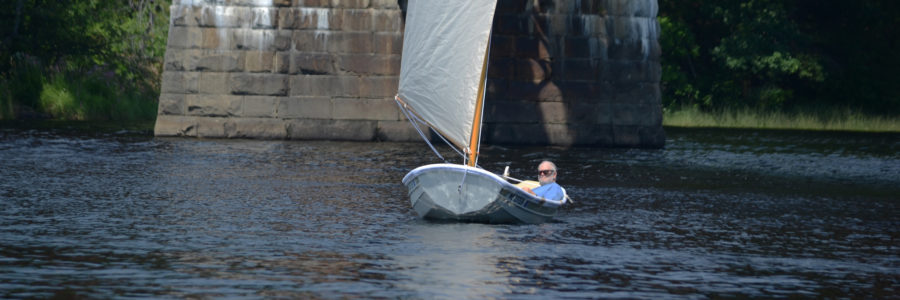
Doug designed Oonagh “to combine some of the best qualities of inflatables with the advantages of a traditional dinghy and put it into a package that is a little less…
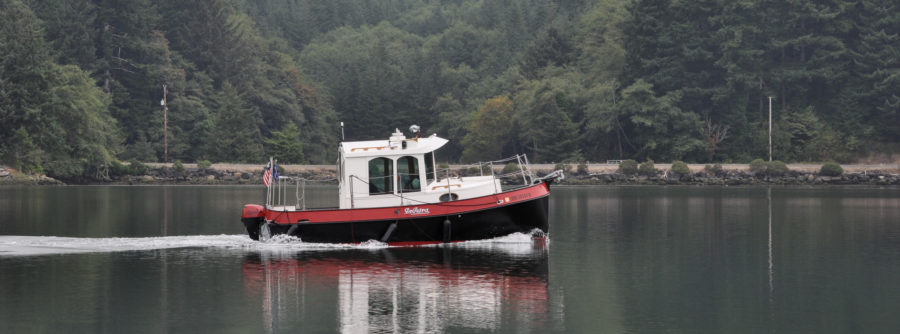
Glen-L Bo-Jest
The three pages of plans were clear, but required extra study for me as this was my first plans-built boat. (I had previously built an Adirondack guideboat from a partial…
Subscribe Today!
Become a subscriber today and you’ll recieve a new issue every month plus unlimited access to our full archive of backlogged issues.
Already a subscriber? Sign In
Subscribe For Full Access
Flipbooks are available to paid subscribers only. Subscribe now or log in for access.
Jump to navigation
Search form
- Crew Finder
- Century Club
- Start Sailing Now
- Racing Team
- See The Bay
- Boats For Sale
- Boat Reviews
- Classifieds
O'Day 40 Used Boat Review
Posted April 5, 2017
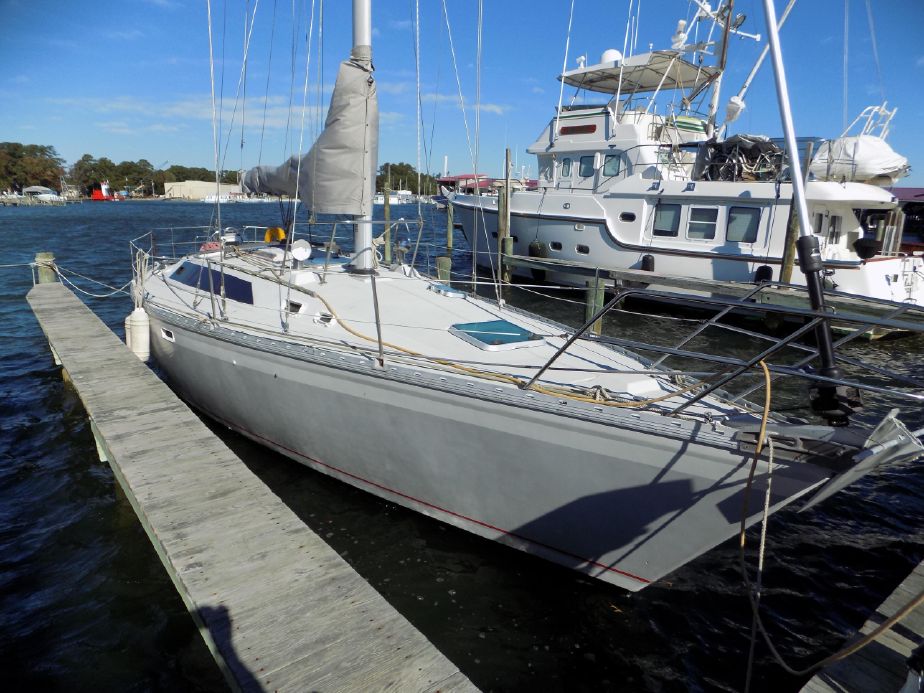
Although O’Day Boats, of Fall River, MA, failed to survive a previous downturn in our economy, the company’s 30+ years building affordable daysailers and family cruisers introduced more than a few sailors of my generation to our sport. In these tough economic times, it’s perhaps fitting that we take a look at the O’Day 40—still one of the more affordable family cruisers of this size and age.
Introduced in 1985, the O’Day 40 is the largest model ever built by the company and remained in production until 1989. Although there are enough similarities to consider this a redesign of the earlier O’Day 39, there are enough differences that I’m focusing only on the O’Day 40 for this review.
Depending on the source, design credit for the O’Day 40 goes to C. Raymond Hunt Associates or Philippe Briand. My admittedly limited investigation was not able to confirm, with certainty, but I suspect both likely had a hand in the project. Hunt Associates designed nearly all previous O’Day cruising models, but the distinct European-influence of this design is certainly reminiscent of Briand’s work.
In a departure from previous construction methods, the hull of the O’Day 40 is a cored composite using three-quarters of an inch of balsa, polyester resin, and biaxial fiberglass cloth. Decks are also composite constructed with balsa and plywood core, and structural support is provided by a combination of fiberglass liners, plywood bulkheads, and various longitudinal and athwartship supports. Generally, the quality of construction, fit, and finish is typical of entry-level boats of the 1980s. Attachment of structural components seems to have been done well, and it’s rare to find any serious concerns in these areas.
Unless remedial repairs have been made, O’Day 40s are likely to have some degree of osmotic blistering below the waterline. And, because osmotic blisters and water permeation can be more problematic on balsa cored composites, it is best to get a knowledgeable professional’s evaluation if blisters are present or suspected. Cracking and crazing of the fiberglass decks are also quite common and sometimes severe enough to affect the structural integrity; so any questionable areas should also be evaluated by a professional.
The O’Day 40 has a nicely designed deck featuring a low cabin trunk which gradually slopes to the foredeck. Cabin sides are angled to wide side decks providing a secure footing as the boat heels. There is a large anchor locker on the foredeck and a perforated, extruded aluminum toe rail. The cast aluminum lifeline stanchions are at the rail, so lifelines do not intrude on deck space. Cockpit seating is comfortable with a deep seat locker to port and a shallow locker to starboard. There is a gate in the stern rail for access to a small “sugar scoop” transom swim deck with a folding boarding ladder that can be reached by someone in the water. This is a safety feature now recommended by ABYC standards, and O’Day was ahead of their time.
The interior arrangement is fairly standard with a V-berth cabin forward followed by a port head/shower and a starboard hanging locker. The main saloon has a U-shaped dinette with a drop-leaf table to port and a settee to starboard. There is a spacious galley aft to port with a forward facing navigation station opposite. The quarter berth cabin has a large athwartship, double berth tucked under the cockpit. While there is plenty of head room, hip room is tight, and whoever sleeps aft must crawl over the head of his bunk mate in order to exit first.
Not such a good idea is the extra head crammed into the quarter berth cabin which offers no privacy for users. The space would be much better utilized for storage.
Auxiliary power is provided by a Westerbeke 46-horsepower marine diesel engine which is more than adequate for a boat whose design displacement is less than 20,000 pounds. The engine is located below the companionway steps, and reasonable access is provided by removing the steps and access panels along the starboard side and aft.
The O’Day 40 has a rather conservative sail area/displacement ratio of only 16.3, but is also on the light side, for a mid-1980s cruiser, with a displacement/length ratio of 214. One measure of performance, U.S. Sailing’s PHRF (Performance Handicap Racing Fleet) rating shows an average handicap of 114 for the O’Day 40. For comparison to other boats of the same era, her rating is 39 seconds per mile slower than the popular J/40 racer/cruiser and 57 seconds per mile slower than the “strictly cruising” Island Packet 38.
Affordability is what attracted buyers to the O’Day 40 when she was new, and it remains an attraction more than 20 years later. Presently, there are seven O’Day 40s listed for sale at the yachtworld.com website with asking prices ranging from $59,000 to $89,000. The average selling price over the last year has been $55,000. For price comparison only, selling prices of similar age J/40s and Island Packet 38s have averaged $120,000 and $108,000, respectively.
I don’t mean to compare the quality of these models, but despite some flaws common to most aging, entry-level sailboats, the O’Day 40 remains a lot of boat for the money and could be an excellent value, particularly for sailors capable and willing to invest some of their own “sweat equity” in needed maintenance and repairs.
Specifications: LOA 39’ 7” LWL 33’ 6” Beam 12’ 7” Displacement 18,500 lbs Draft 4’ 11” Shoal 6’ 4” Deep

- Privacy Policy
Sailboat class / From Wikipedia, the free encyclopedia
Dear wikiwand ai, let's keep it short by simply answering these key questions:.
Can you list the top facts and stats about O'Day 30?
Summarize this article for a 10 year old
The O'Day 30 is an American sailboat that was designed by C.R. Hunt & Associates as a cruiser and first built in 1977. [1] [2] [3]
The O'Day 30 design was developed into the O'Day 31 in 1985 with the addition of an extended stern. [1]

- Forums New posts Unanswered threads Register Top Posts Email
- What's new New posts New Posts (legacy) Latest activity New media
- Media New media New comments
- Boat Info Downloads Weekly Quiz Topic FAQ 10000boatnames.com
- Classifieds Sell Your Boat Used Gear for Sale
- Parts General Marine Parts Hunter Beneteau Catalina MacGregor Oday
- Help Terms of Use Monday Mail Subscribe Monday Mail Unsubscribe
O'day 302 Owner Reviews
- Thread starter James
- Start date Aug 19, 2005
- Oday Owner Forums
- Ask An Oday Owner
I'm looking for owner reviews of the O'Day 302. Please do not tell me what you have heard or read about the boat. Only reply if you have owned or sailed the 302. I've gotten "he said / she said" reports but not any first hand accounts. Any real information you can provide will be greatly appreciated.
Rod Phillips
Own a302 I currently own and sail out of Englewood Fl a 302, and enjoy the boat very much. We have a 1989 and have owned the boat for about 10 years.If you would like detailed information let me know at [email protected]
DON'T BUY IT WARNING! DO NOT BUY THIS BOAT. I HIT A ROCK AT 3 KNOTS UNDER POWER AND THE KEEL FELL OFF. THERE WERE NO BACKING PLATES. THE ONLY THING HOLDING THE KEEL ON THE BOAT WERE THE KEEL BOLTS ATTACHED TO THE THIN FIBERGLASS HULL.
You mean to tell me that... ...the 302 does not have a keel trunk? I find this hard to believe! If this is truly the case, keels would be dropping off of 302's in wholesale lots. Cheers, Bob
- This site uses cookies to help personalise content, tailor your experience and to keep you logged in if you register. By continuing to use this site, you are consenting to our use of cookies. Accept Learn more…

IMAGES
VIDEO
COMMENTS
Sailboat Reviews; Sailboats 21-30ft; O'Day 30 With good performance, low maintenance, and a big interior, the 30 is a good coastal cruiser. By. Darrell Nicholson - Published: June 14, 2000 Updated: October 26, 2021. 2. Facebook. Twitter. Email. Print. The first O'Day 30 we saw back in 1977 was named Moby Dick. Compared to most of the boats ...
It takes into consideration "reported" sail area, displacement and length at waterline. The higher the number the faster speed prediction for the boat. A cat with a number 0.6 is likely to sail 6kts in 10kts wind, a cat with a number of 0.7 is likely to sail at 7kts in 10kts wind. KSP = (Lwl*SA÷D)^0.5*0.5
Oct 20, 2016. #4. For someone relatively new to sailing and not racing, the O'day 30 (or indeed ANY production boat) will sail fine. Of much more importance to your overall happiness with the boat will be its condition. It's a 35 year old boat, and has systems that you're not used to on your Mac.
Boat: Spacesailer 20. Posts: 128. Opinions of 1978 O`Day 30. I've been doing research about the 1978 O`Day 30 that is for sale near where I live and I have heard many mixed and varied opinions about the build quality and sea worthiness of this boat. This is the keel version of the O`Day 30 and looks like it is in very good condition.
O'Day 30 is a 29′ 11″ / 9.1 m monohull sailboat designed by Raymond Hunt (C.R. Hunt & Assoc.) and built by Bangor Punta Corp. and O'Day Corp. between 1977 and 1984. ... Sail area in square feet, derived by adding the mainsail area to 100% of the foretriangle area (the lateral area above the deck between the mast and the forestay). D: ...
25. O'Day 30 Wilmington. Feb 27, 2021. #1. Looking for any information, things to check, opinions, and anything helpful for an O'Day 30...I think. After a number of years being boatless, my wife and I are in early stages of beginning to look at boats. One that has caught our eye says it is an 1984 O'Day 32.
If you want to know more about the O'Day 30, there's a review of the boat at Practical Sailor. You have to pay for the review, but it might be worth it. Hope this helps! ... Now that I have bored you to death with my pedigree, the real question comes regarding this 1978 O'Day 30 I'm looking at. Asking $8500. New mast, boom, standing and running ...
The O'Day 30 is an American sailboat that was designed by C.R. Hunt & Associates as a cruiser and first built in 1977. The O ... A review in Practical Sailor described the design, "All things considered, the O'Day 30 is a boat that performs well under sail. She's not really a racer, but she will stay up with almost any boat of her size and ...
O'DAY 30 Detailed Review. If you are a boat enthusiast looking to get more information on specs, built, make, etc. of different boats, then here is a complete review of O'DAY 30. Built by O'Day Corp. and designed by Raymond Hunt (C.R. Hunt & Assoc.), the boat was first built in 1977. It has a hull type of Fin w/spade rudder and LOA is 9.12.
The O'day 30 is a 29.92ft masthead sloop designed by Hunt & Associates and built in fiberglass by O'Day Corp. between 1977 and 1984. 356 units have been built. The O'day 30 is a moderate weight sailboat which is slightly under powered. It is very stable / stiff and has a good righting capability if capsized. It is best suited as a coastal cruiser.
The DL-ratio for O'Day 30 is 288 which categorizes this boat among 'medium weight cruisers'. Heavy Light 34% 0 50 100. 34% of all similar sailboat designs are categorized as heavier. A heavy displacement combined with smaller water plane area has lower acceleration and is more comfortable.
Other more recent entries in this sub-genre include Marshall Marine's catboat line, Com-Pac Yacht's Picnic Cat and Sun Cat, Bauteck Marine's Bauer line, the NorseBoat 12.5 and 17.5, and the Crabber 17, 22 and Shrimper at the small end of the Cornish Crabber line.. And let's not forget that quirkiest of boats, the Melonseed skiff, built by the Crawford Boat Building company.
O'Day sailboats are generally well-regarded for their quality and performance. They have been in production since the 1960s and incorporate modern designs and materials to ensure excellent sailing performance. The quality of the craftsmanship is reliable and the boats are known for their comfort and ease of use.
So, for inland seas and coastal work, yes a maintained 25 is considered sea worthy. Each boats seaworthiness must be evaluated against worst possible conditions. Going away from shore could easily expose you to 30 or 50 knot winds. I have a 26 and would not want to expose myself above 30 knots.
The resulting Day Sailer was a 16'9" centerboarder with a displacement of 575 lbs, which makes for a light load to tow behind the family car. The fractional sloop rig includes a generously sized spinnaker for exciting downwind sailing.The first Day Sailer was sold in 1958 and immediately became popular in the recreational and racing markets.
For comparison, the J/35, an extremely popular and successful racer/cruiser of about the same era, has a displacement/ length ratio of 165 and a sail area/displacement ratio of 21.8. While O'Day's numbers certainly don't reflect an all out racer/cruiser, none the less, the 34/35 is a decent performer and, when well equipped and sailed, is ...
Presently, there are seven O'Day 40s listed for sale at the yachtworld.com website with asking prices ranging from $59,000 to $89,000. The average selling price over the last year has been $55,000. For price comparison only, selling prices of similar age J/40s and Island Packet 38s have averaged $120,000 and $108,000, respectively. I don't ...
Dave. May 8, 2004. #1. My wife ran across a 1974 O'Day 20 at a yard sale (!) with the owner asking $2,500, including the trailer and 75cc Honda motor (8 hours use since a rebuild). I haven't even seen it yet, so can't comment on its condition.u000bu000bBut here's the question: we're both wannabe sailors.
The O'Day 30 is an American sailboat that was designed by C.R. Hunt & Associates as a cruiser and first built in 1977.
Rod Phillips. Aug 22, 2005. #2. Own a302. I currently own and sail out of Englewood Fl a 302, and enjoy the boat very much. We have a 1989 and have owned the boat for about 10 years.If you would like detailed information let me know at [email protected]. M.
A sailboat built by O'Day, the 30 is a cruisers vessel. O'Day 30 boats are typically used for overnight-cruising, sailing and watersports. Got a specific O'Day 30 in mind? There are currently 3 listings available on Boat Trader by both private sellers and professional boat dealers. The oldest boat was built in 1982 and the newest model is 1986.